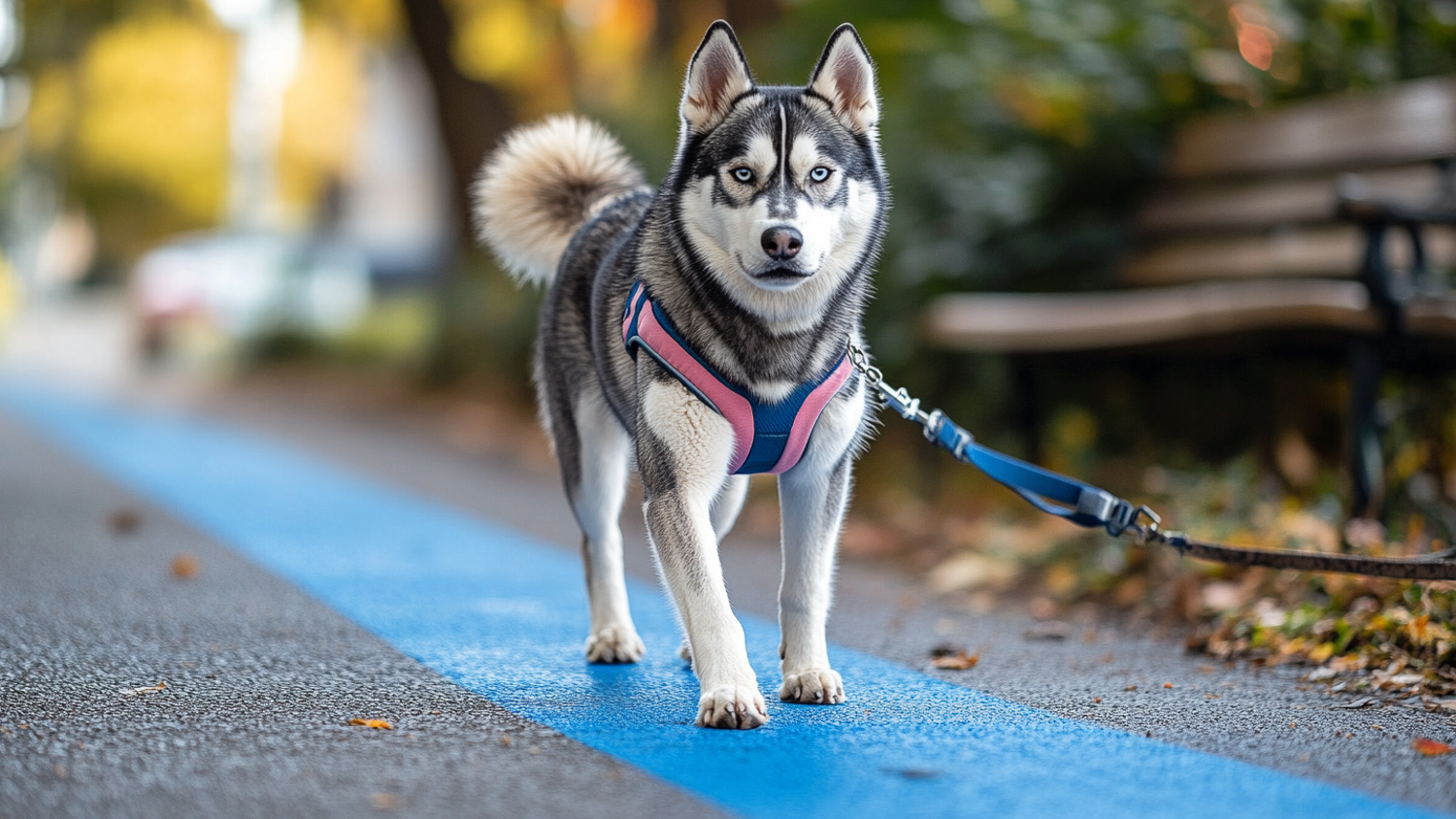Training a Husky to follow the heel command requires understanding their unique temperament and energy levels. These intelligent and independent dogs respond well to consistent, positive reinforcement techniques. Establishing clear expectations and using patience are key to successfully teaching a Husky to walk calmly by your side.

The heel command is essential for maintaining control during walks and ensuring your Husky’s safety in various environments. It involves teaching your dog to walk close to your left side, matching your pace and stopping when you stop. This skill not only enhances obedience but also strengthens the bond between you and your Husky.
Starting with short training sessions and gradually increasing duration and distractions will help your Husky master the heel command. Rewarding good behavior with treats, praise, and play encourages them to repeat the desired action. Regular practice in different settings reinforces the command and helps your Husky generalize the behavior across various situations.
Key Takeaways
- Consistent positive reinforcement is crucial for teaching Huskies the heel command
- Start with short training sessions and gradually increase difficulty to build success
- Regular practice in different environments helps reinforce and generalize the heel behavior
Understanding Husky Behavior and Preparing for Training
Huskies have unique traits that influence their training needs. Proper preparation and understanding are essential for successful heel command training.
Characteristics of Huskies
Huskies are energetic, intelligent sled dogs with a strong prey drive. They possess an independent nature and can be stubborn during training. These dogs require consistent exercise and mental stimulation to prevent behavioral issues.
Huskies have a high endurance level, originally bred for pulling sleds over long distances. This stamina translates to a need for regular physical activity and structured playtime.
Without adequate exercise, they may become restless or destructive.
Their pack mentality makes socialization crucial. Early exposure to various environments, people, and other animals helps create a well-adjusted husky. This socialization also aids in reducing distractions during training sessions.
Setting the Stage for Successful Heel Training
Creating a suitable training environment is key for teaching huskies the heel command. Choose a quiet area with minimal distractions to start. Gradually introduce more challenging settings as training progresses.
Establish a consistent routine for training sessions. Short, frequent sessions work best for maintaining a husky’s attention. Aim for 10-15 minute sessions, 2-3 times daily.
Patience is crucial when training huskies. Their independent nature may lead to occasional stubbornness. Remain calm and persistent, using positive reinforcement techniques to encourage desired behaviors.
Incorporate training into daily activities. Practice the heel command during walks or before meals. This integration helps reinforce obedience in various situations.
Core Training Techniques for Heel Command
Teaching a husky to heel requires consistency, patience, and positive reinforcement. The following techniques focus on introducing the heel position, using rewards effectively, and incorporating training into daily walks.
Introducing the Heel Position
Begin by standing with your husky on your left side. Hold a treat near your hip to encourage the dog to stay close. Take a step forward and reward your husky for moving with you. Repeat this process, gradually increasing the number of steps.
Use a verbal cue like “heel” or “let’s go” as you start moving. Reward your husky for maintaining the correct position. If your dog moves out of position, stop and reset.
Practice in a quiet area with minimal distractions initially. Gradually increase the difficulty by training in more stimulating environments.
Using Positive Reinforcement and Rewards
Reward your husky with treats, praise, or toys when they correctly follow the heel command. Use high-value treats like small pieces of chicken or hot dogs during initial training sessions.
Consider using a clicker to mark the exact moment your husky is in the correct position. Click and immediately reward to reinforce the behavior.
Vary the rewards to keep your husky engaged. Alternate between food treats, verbal praise, and brief play sessions. Gradually reduce the frequency of treats as your dog becomes more proficient.
Practicing Heel during Daily Walks
Incorporate heel training into your daily walks. Start each walk with a short heel exercise before allowing more freedom to explore.
Use structured walks to reinforce the heel command. Alternate between periods of heeling and free sniffing time. This helps maintain your husky’s focus and reinforces leash manners.
Practice changing pace and direction while heeling. Start with slow, steady walking and gradually introduce faster paces. Make sudden stops or turns to keep your husky attentive.
If your husky pulls or moves out of position, stop walking immediately. Only resume when they return to the heel position. This teaches them that walking nicely leads to forward progress.
Advancing Your Husky’s Heel Training
Progressing your Husky’s heel training requires consistency, patience, and adaptability. Focus on gradually increasing challenges while reinforcing good behavior.
From Structured Training to Real-World Situations
Start in low-distraction environments and slowly introduce new elements. Practice heeling in different locations like parks or streets. Vary walking speeds and directions to keep your Husky engaged. Use treats sparingly as you transition to verbal praise and petting.
Incorporate obstacles like trees or benches to test your Husky’s focus. Gradually increase the duration of heeling sessions. Practice in busier areas with more distractions, but be prepared to return to easier environments if needed.
Work on off-leash heeling in secure areas. Start with short distances and build up. Always prioritize safety and have a reliable recall command before attempting off-leash work in public spaces.
Challenges and Common Mistakes to Avoid
Huskies can be easily distracted. Maintain a calm, assertive energy to keep their attention. Avoid repeating commands; this teaches the dog to ignore the first cue. Instead, use gentle leash guidance or body blocking to redirect their focus.
Be consistent with expectations. Don’t allow pulling sometimes and expect perfect heeling at others. This confuses the dog and hinders progress. Watch for signs of fatigue or boredom, which can lead to non-compliance.
Don’t rush the training process. Each Husky learns at their own pace. Pushing too hard can create anxiety or resistance.
Keep sessions short and positive. End on a successful note to build confidence and enthusiasm for future training.
Further Opportunities Beyond Basic Heel Training
Mastering the heel command opens up new avenues for training and bonding with your Husky. Advanced techniques and specialized activities can further enhance your dog’s skills and obedience.
Engaging in Dog Sports and Advanced Training
Dog sports provide an excellent opportunity to refine your Husky’s heel training. Consider participating in rally competitions, which incorporate heeling exercises with other obedience skills. These events test your dog’s ability to follow commands while navigating a course.
Agility training also builds upon heel work, requiring precise control as you guide your Husky through obstacles. Start with basic equipment like weave poles and jumps, gradually increasing difficulty.
Trick training can incorporate heel elements, teaching your Husky to walk backwards or sideways while maintaining position. Use treats and positive reinforcement to encourage these more complex behaviors.
When to Consult a Professional Trainer
If your Husky struggles with consistent heeling or exhibits behavioral issues during training, seeking professional help may be beneficial. A certified trainer can identify underlying problems and provide tailored solutions.
Professional trainers offer specialized classes for advanced obedience, including off-leash heeling and distraction training. These courses help solidify your Husky’s skills in various environments.
For older dogs or those with ingrained habits, a professional can develop a targeted plan to address specific challenges. They may recommend tools like different collars or harnesses to improve training effectiveness.
Consult resources like AKC.org to find reputable trainers in your area. Look for those experienced with working breeds like Huskies for the best results.


Leave a Reply